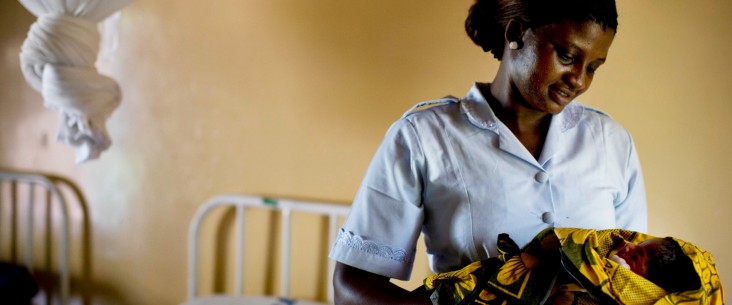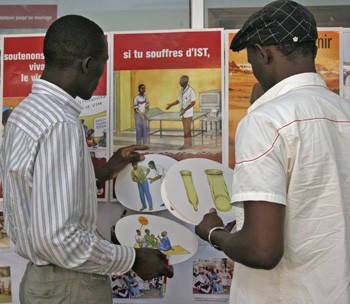- What We Do
- Agriculture and Food Security
- Democracy, Human Rights and Governance
- Economic Growth and Trade
- Education
- Ending Extreme Poverty
- Environment and Global Climate Change
- Gender Equality and Women's Empowerment
- Global Health
- Water and Sanitation
- Working in Crises and Conflict
- U.S. Global Development Lab

The Unmet Need for Family Planning
At a Glance
More than 214 million women globally have an unmet need for family planning, meaning that they want to delay or avoid pregnancy but are not using a modern method of contraception. Approximately one in four women in sub-Saharan Africa have an unmet need for family planning, and women living with HIV have even more limited access to family planning and reproductive health services than the general population. Ensuring all women living with HIV have access to these services can significantly reduce unintended pregnancies, maternal deaths (including those related to HIV) and new pediatric HIV infections. Choosing the number, timing and spacing of children is a basic right of all women and couples, no matter their HIV status, and USAID works to increase access to family planning information and services for all who want it. However, specific considerations must be addressed to ensure comprehensive care for people living with or affected by HIV.
USAID’s Response
The U.S. Agency for International Development (USAID) recognizes that integrating HIV and family planning activities provides opportunities to simultaneously reduce the incidence of HIV and AIDS and the unmet need for family planning. Integration activities will contribute to the achievement of an AIDS-Free Generation [PDF, 2.83MB] and to the achievement of Family Planning 2020’s global goals. Family planning and HIV and AIDS programs often serve similar populations, particularly in countries with generalized HIV epidemics. The strategic combination of family planning and HIV services is essential to offering the highest quality of care to the populations USAID serves especially people living with HIV/AIDS and key populations, through both HIV and family planning settings,. When programs and services meet multiple client needs, satisfaction with the health system increases, and scarce financial and human resources are better utilized.
Guidance from the Office of the U.S. Global AIDS Coordinator has encouraged expanded access to voluntary family planning services and safe pregnancy counseling across HIV prevention, care and treatment platforms with special attention to care and treatment; prevention of mother-to-child transmission of HIV (PMTCT); key populations; and health systems strengthening. Integrating HIV counseling and testing into family planning service delivery settings; including outreach and community based distributor activities is a promising practice that can increase access to integrated services and strengthen family planning and HIV outcomes. In addition, USAID in collaboration with PEPFAR partners is actively engaged in analyzing and interpreting available data on key integration issues such as hormonal contraception-HIV acquisition and hormonal contraception- ART interactions. USAID also supports the development of innovative contraceptive technologies to protect against unintended pregnancy, HIV and other sexually transmitted infections.
The U.S. Government global health strategy to meet the family planning needs of women living with HIV is based on three key guiding principles:
- A focus on reproductive rights through voluntarism and informed choice
- Quality service provision through evidence-based programming
- Development of partnerships
The integration of health programs, including HIV and family planning programs, is a priority for the U.S. Government and is outlined as a key strategy to strengthen existing foreign assistance programs under the Global Health Initiative. USAID is a key implementing partner of the U.S. President’s Emergency Plan for AIDS Relief (PEPFAR) and provides leadership for the newly formed PEPFAR Interagency FP/HIV Task Force. Integrated services can ensure that all people living with HIV and AIDS have access to family planning services that support their fertility choices. USAID coordinates with other agencies at the country level to make integrated services available to the clients we serve. PEPFAR funds cannot be used to procure contraceptive commodities except for male and female condoms. Therefore, it is critical that USAID missions, in partnership with national governments, provide technical leadership and support to ensure that a wide range of family planning commodities are available in USAID supported health sites, including HIV service delivery sites where family planning method provision is a part of the service delivery package.
Many USAID Missions are successfully implementing family planning and HIV integration activities. USAID encourages and facilitates south to south sharing of knowledge and technical resources in the field.
Key country-level activities include:

- Supporting various models of integration that are suitable for different country and regional contexts, as there is no “one size fits all” approach to family planning and HIV integration.
- Where family planning commodities are needed, facilitating PEPFAR’s participation in country-led contraceptive planning and distribution processes to make sure that commodities needs within HIV platforms are taken into account.
- Serving in a leadership role in provider training and quality assurance for family planning service provision. USAID family planning programs coordinate with other U.S. Government agencies to identify family planning training needs within supported service delivery platforms and work together to meet those needs.
- Supporting research studies, documenting best and promising practices and providing technical assistance to national programs to scale up integration models.
- Supporting an enabling environment for family planning and HIV integration, including support for the creation of family planning and HIV integration technical working groups to develop and disseminate national policies related to integration.
- Identifying critical system barriers and constraints and designing programs to address them.
- Ensuring linkages between family planning and HIV service delivery stakeholders, including PMTCT, care and treatment, key populations and health systems strengthening programs.
USAID supports a woman’s right to use or not use family planning regardless of HIV status. Her decision should be free of any discrimination, stigma, coercion, duress or deceit and informed by accurate, comprehensive information and services, including access to a variety of contraceptive methods. In addition, the provision of health services, including ART, should never be conditioned on acceptance of a family planning method.
- Learn about USAID’s family planning guiding principles and U.S. legislative and policy requirements.
Additional Resources

- Issue Brief: Decreased Contraceptive Efficacy Reported in Women Living with HIV Who Use Implants While Taking the Antiretroviral Efavirenz [PDF, 425KB]
- Family Planning and HIV Service Integration eLearning Course (available in Arabic, English, French, Portuguese, and Spanish)
- Family Planning and HIV Integrated Supply Chains [PDF, 502KB]
- Integrating Family Planning into HIV Programs: Evidence-Based Practices [PDF, 485KB]
- Issue Brief: Family Planning and HIV Prevention Integration [PDF, 51KB]
- Issue Brief: Drug Interactions between Hormonal Contraceptive Methods and Anti-Retroviral Medications Used to Treat HIV [PDF, 463KB]
- Systematic Review of Integration of Maternal, Neonatal and Child Health, and Nutrition, Family Planning and HIV: Final Report [PDF, 600KB]
- K4Health Toolkit on Integration of Family Planning and HIV Services
- PEPFAR Blueprint [PDF, 2.83MB]
- PEPFAR FY 2015 Technical Considerations (starting on pg. 306) [PDF, 8.5MB]
- Hormonal Contraception-HIV Technical Update [PDF, 735KB]
- Hormonal Contraception-HIV Overview (September 2013) [PDF, 160KB]
- Hormonal Contraception-HIV Overview (September 2013) (French) [PDF, 220KB]
- Hormonal Contraception-HIV Overview (September 2013) (Arabic) [PDF, 289KB]
- Hormonal Contraception-HIV Overview (September 2013) (Portuguese) [PDF, 133KB]
- Hormonal Contraception-HIV Overview (September 2013) (Spanish) [PDF, 134KB]
- WHO, USAID, FHI360: Strategic Considerations for Strengthening the Linkages between Family Planning and HIV/AIDS Policies, Programs and Services
- UNFPA: Preventing HIV and Unintended Pregnancies: Strategic Framework 2011-2015 [PDF, 2.44MB]
- SRH & HIV Linkages Resource Pack
- WHO/RHR: Medical Eligibility Criteria for Contraceptive Use
- WHO, UNFPA, IPPF, UNAIDS, UCSF: Linkages: Evidence Review and Recommendations [PDF, 6.64MB]







Comment
Make a general inquiry or suggest an improvement.